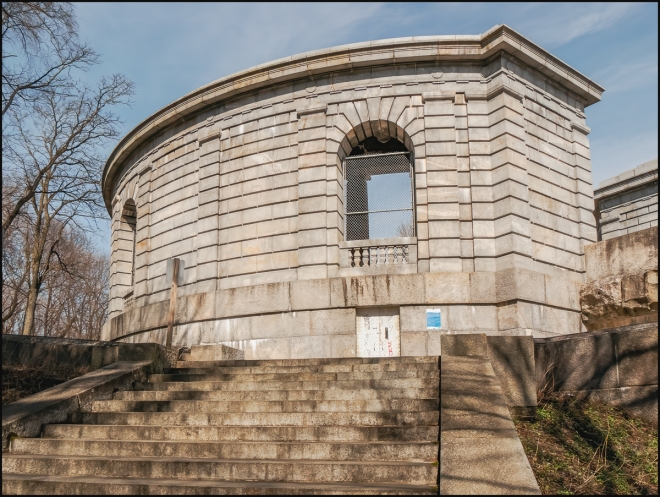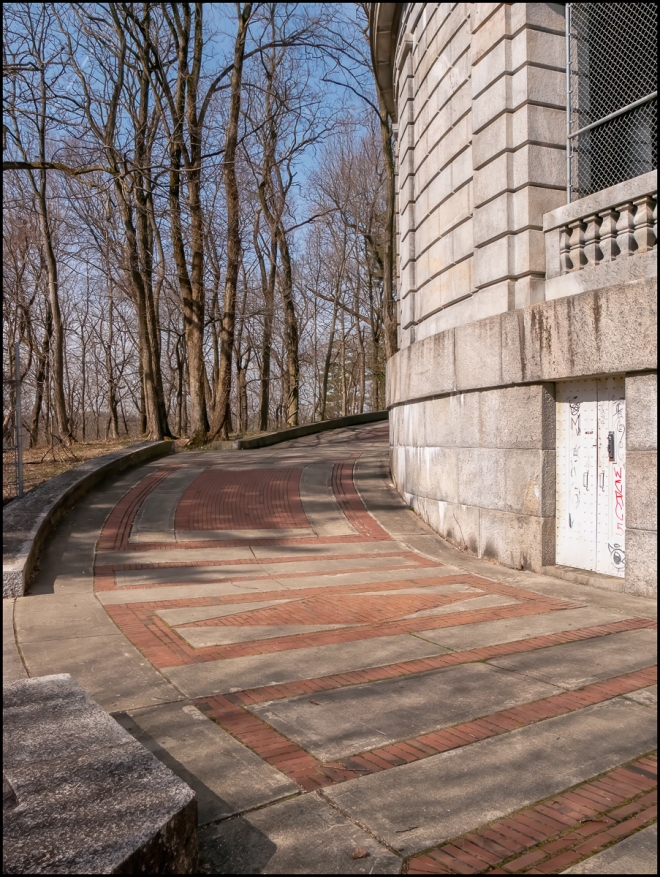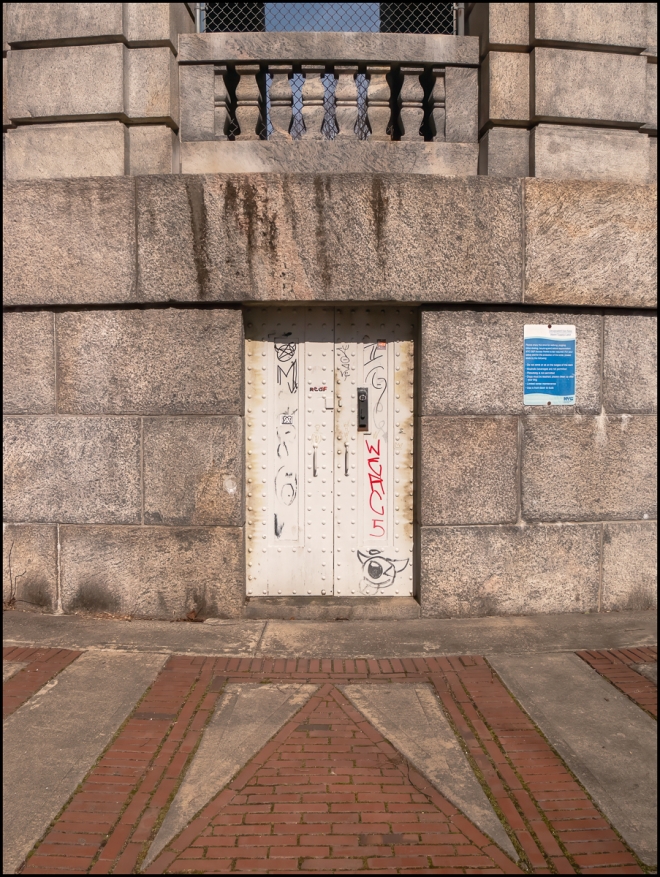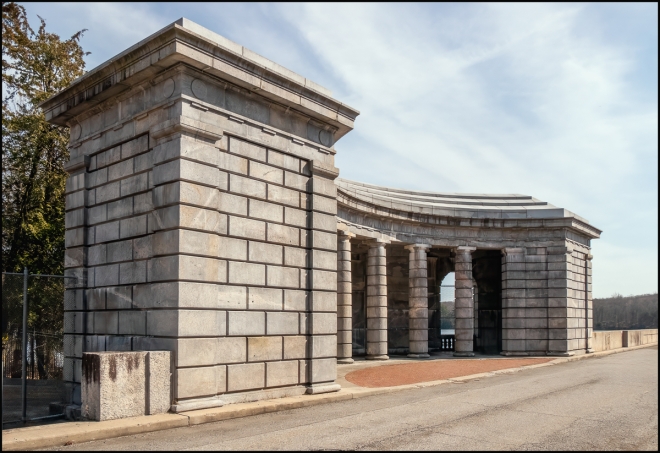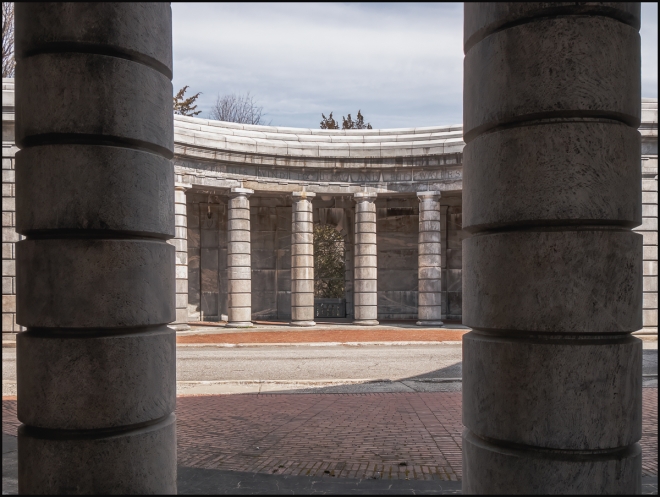This was what greeted my when I got to the end of the steps. It seemed as if I had been transported to Ancient Greece. Pretty Impressive. The Architect was Frank Windsor.
Frank Edward Winsor (1870-1939) was the chief engineer for the Boston Metropolitan District Water Supply Commission, now the Massachusetts Water Resources Authority, from 1926 until his death in 1939 and was closely involved in the design and construction of Winsor Dam and Goodnough Dike which were built by the Commission to create the Quabbin Reservoir in Massachusetts. Winsor Dam was named for him. He was born November 16, 1870, in Providence, Rhode Island and died on January 30, 1939, a resident of West Newton, Massachusetts, where he had lived for many years at 189 Mt. Vernon Street. He received a Ph.B in 1892, an A.M. in 1896 an Sc.D. in 1929, all from Brown University. He later sat on Brown’s Board of Trustees. He was licensed as a Civil Engineer in 1892. On October 25, 1893, Frank E. Winsor married Catherine Holbrook Burton, who later taught at Brown. They had two daughters and a son. Their oldest child, Lucy, (April 16, 1897 – October 9, 1989), was a professor of economics at Wellesley College. She was married to Hugh B. Killough, (December 30, 1892 – December 13, 1976) who was a professor of economics at Brown. Together they wrote many books on business, economics and industry. His early work was on water and sewer projects for Boston. He was one of the engineers on the design and building of the Wachusett Dam. He also did work for the Charles River Basin Commission. From 1903-1915 he worked on projects for New York City including being in charge of the construction of the Kensico and Hillview reservoirs and 32 miles of Catskill Aqueduct. Frank E. Winsor was a Fellow of the American Academy of Arts and Sciences and a director and vice president of the American Society of Civil Engineers. From 1915-1926, he was chief engineer for the new water supply project for Providence, which involved the design and construction of the Scituate Reservoir and the earthen dam necessary to create it and the building of a water treatment plant. Like Quabbin Reservoir in Massachusetts, Scituate Reservoir is the largest body of water in its state. At the completion ceremonies for the project on September 30, 1926, Providence Mayor Joseph H. Gainer called Winsor “[T]he man to whom most of the credit for this undertaking belongs.” The dam is known today as the Gainer Memorial Dam in honor of the mayor. He left his successful work on the Scituate Reservoir for Providence to go on to greater work as chief engineer for the Metropolitan District Water Supply Commission in Massachusetts. His greatest accomplishment was the design and construction of Quabbin Reservoir and the Winsor Dam and Goodnough Dike which were built to dam the waters of the Swift River to create the reservoir. The dams were finished shortly after his death in 1939, but the Quabbin Reservoir did not fill to its maximum holding capacity until 1946. (Adapted from Wikipedia)
A pavilion is located at either end of the dam. It’s split into a north side and a south side, with the road passing through the middle. I guess he must have liked neo-classical architecture.
Interior view of the north side of the Kensico Dam West Pavilion. There’s lettering over the columns but I didn’t spot it at the time and so didn’t record what it said. From the pictures I think it’s from Psalm 146:18, which reads: “He sendeth out his word, and melteth them: he causeth his wind to blow, and the waters flow.” I think the lettering of on the north side of the west pavilion (seen in this photograph) has the second part (“He causeth his wind to blow, and the waters flow.” I’m guessing that the inscription on the south side probably contains the first part (“He sendeth out his word, and melteth them”). Once upon a time you could have looked through the arches towards the reservoir. You still can, but the view is somewhat obstructed by the mesh put there, presumably to stop people from jumping.
The North Castle Historical Society has an interesting video entitled: “The Lost Village of Kensico and the building of the Kensico Dam”
A site called Building the Kensico Dam and Reservoir has a fascinating series of Annual Reports covering the period 1906-1920. They’re full of interesting facts, old photographs, and diagrams showing the structure of the dam.
Taken with a Panasonic Lumix GX85 and Lumix G Vario 14-140 f3.5-5.6

